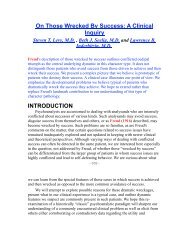A Sadomasochistic Transference - Beth J. Seelig, MD
A Sadomasochistic Transference - Beth J. Seelig, MD
A Sadomasochistic Transference - Beth J. Seelig, MD
Create successful ePaper yourself
Turn your PDF publications into a flip-book with our unique Google optimized e-Paper software.
(because she had yelled so much). Miss T. taunted the analyst by saying she would<br />
just have to live with the uncertainty of whether or not she would kill herself, and<br />
if the analyst tried to hospitalize her, she knew exactly what to say and how to act<br />
so that she would never be admitted. She gloated over this fantasy in which the<br />
analyst looked like a fool in front of the psychiatric resident in charge of<br />
admissions. Retaining an analytic stance in the face of this intense aggression was<br />
difficult, and led on a few occasions to failures of empathy which further fueled<br />
the patient's rage. At times the thought crossed the analyst's mind that life would<br />
be easier if Miss T. would go ahead and kill herself (a complementary<br />
countertransference position as described by Racker, 1957).<br />
During this time, as Miss T. continued to heap vituperations on the analyst<br />
and to act out her rage with her boyfriend at home, she behaved appropriately at<br />
work and became a valued employee. She accused the analyst of secret amusement<br />
because she was certain that the analyst knew that she (Miss T.) was unable to<br />
leave the analysis no matter how badly she was being abused. The analyst pointed<br />
out that while Miss T. was accusing her analyst of getting secret pleasure out of<br />
Miss T.'s suffering, Miss T. was in fact secretly enjoying berating the analyst and<br />
feeling morally superior to her. This was rejected, as were other interventions, as<br />
an effort to "turn everything around and make<br />
- 972 -<br />
me [Miss T.] feel crazy." At the end of one of these furious hours, she stated, "I<br />
don't think it'll be a good analysis, but there's no choice, so we'll sit here in this<br />
battle for years and years."<br />
It should be repeated that these rageful sessions did not represent the entire<br />
analysis during this period. Intermittently, Miss T. would talk calmly about her<br />
work or social activities, as if the rage did not exist. The analyst became aware of<br />
a countertransferential reluctance to disturb this calm, sometimes feeling as if she<br />
and the patient were together in the eye of a hurricane. When the storm resumed,<br />
the analyst found herself wishing that Miss T. would leave and go torture some<br />
other analyst—for instance, her supervisor.<br />
Miss T. had an extreme need to have every perception validated. When this<br />
need was not met, she could not allow herself even to hear what the analyst said. If<br />
the analyst did not seem to agree with her every perception, then either she or the<br />
analyst had to be "crazy," i.e., totally out of touch with reality. It was this aspect of<br />
the transference that had to be addressed before any further work could be done.<br />
However, it was extremely difficult to subject this attitude to analytic scrutiny,<br />
since to do so meant to present Miss T. with a viewpoint other than her own, an<br />
intervention she experienced as an attack on the core of her being.




